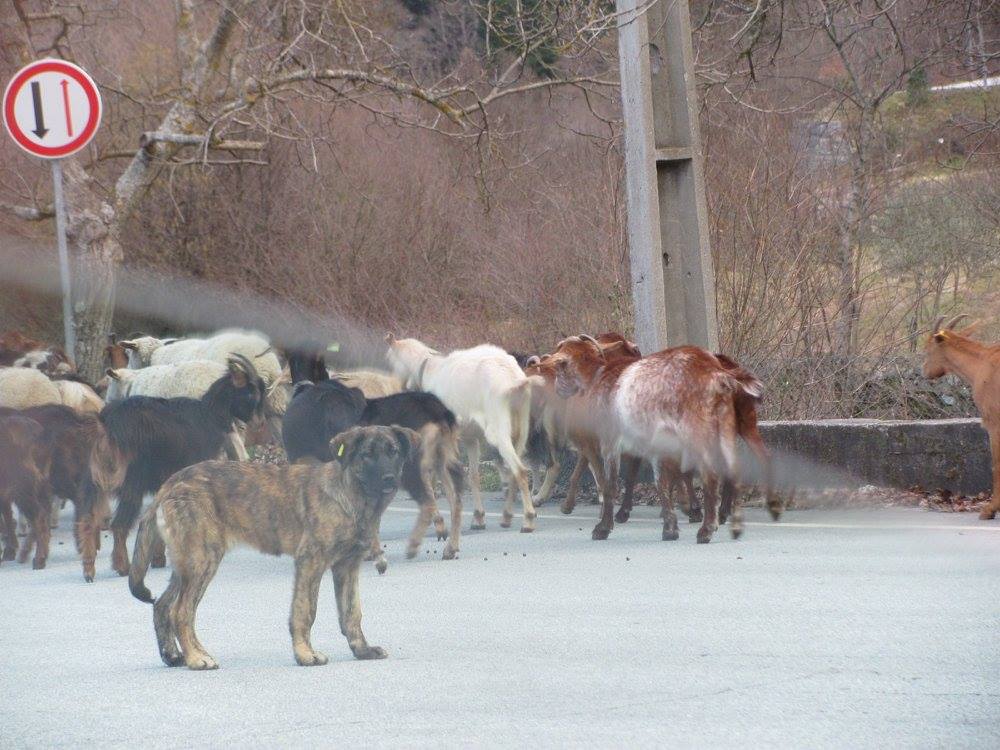
One of the first questions you will be faced with when searching for an LGD puppy or sheepdog is “livestock guardian dogs vs herding dog breeds? ” And if you feel like saying, “well, I just want a farm dog or shepherd dog,” it is crucial to know the differences between these types to inform your decision further. Here are the facts about livestock guardian dogs vs herding dog breeds.
Herding dog breeds are small and agile with a high prey drive that is exhibited in herding behavior. They have high energy and stamina alongside an immense desire to please and do a job. In contrast, livestock guardian dog breeds are much larger with the weight and muscle needed to defend and protect flocks from predators. They are comparatively low-energy, with minimal prey drive and independent problem-solving skills. Both are used with livestock, but they perform opposite roles and should never be mixed or substituted for one another.
Traditionally lumped together, the so-called “shepherd dogs” can do one of two very different jobs requiring specialized skills: whilst some assist in driving the flock (sheepdogs, herding dogs, or livestock conducting dogs), others protect flocks from predators (livestock guarding dogs). Both are an integral part of the traditional European method of livestock husbandry. – Sophia Cruz. Etology and Science
In this article, we will discuss the differences between livestock guardian dogs vs herding dog breeds. I’ll include each type of shepherd dog’s origin, advantages, and disadvantages. You will also discover what makes both suitable for their jobs and why one cannot do the other. Each type is uniquely suited to its own role, and should never be genetically mixed or expected to perform a role it was not genetically selected for.
We would never expect a race car to function as an army tank, neither can we expect a herding dog or herding mix to function as a Livestock Guardian Dog.
Damari
By the end, you’ll know how to choose a dog to perform the function you are looking for. You’ll also know why one type cannot be selected to do the other’s job.
Let’s dive in!
Differences Between Livestock Guardian Dogs vs Herding Dog Breeds.
| Guardian Dog Breeds | Herding Dog Breeds | |
| Appearance | Straighter topline, athletic, muscular, bulkier size, panther like | Sloped back, more angulated, medium-sized dog, athletic appearance |
| Type | Working Group – 6000 Years Old | Herding Group- 900-1000 Years Old |
| Temperament | Low-energy, Low Prey Drive, Protective, Guard-dog, Brave, Loyal, Independent, Intelligent, Confident, Aloof, Alert, Protective of small Animals. | Very energetic, Intense prey drive, Affectionate, Biddable, Intelligent, Confident, Clingy, Suspicious, Loyal, Aggressive towards small Animals. |
| Health | Hip and elbow dysplasia, Other joint issues, Cardiomyopathy, Luxating patella’s, Eye Disorders, DCM, Bloat, Cancer. | Hypothyroidism, Hip and elbow dysplasia, Bleeding Disorders, Deafness, Nerve Disease, MDR1 drug resistance. |
| Coat Type (Length) | Short-medium, Medium, Long | Short, Medium, Long |
| Coat Color | Different breed standards feature different colors. Merle and blue are not original LGD colors and will indicate cross breeding. | Come in a variety of colors. Some breeds feature merle, pied, ticking, black and tan points etc. |
| Cost | $1000+ | $650+ |
Can You Mix Herding And Guarding Breeds to Create a Super Shepherd Dog?

No. Livestock guardian dog breeds mixed with a herding dog breed will result in a dog that is unpredictable, instinctually confused, and conflicted. This dog is not able to perform either of the jobs correctly. This is a common question that people ask about the Guardian and Herding breed dog types. It could be easy to imagine that a mix might inherit the best of both worlds so to speak. Unfortunately, this is never the case.
This Mixed Dog Breed May Be:
- Instinctively confused. May exhibit strong prey, chase, and guard instincts.
- Will not have the body structure or size to successfully defend against predators.
- May have a split personality: hyper/calm, independent/biddable, guardian/prey drive making it unable to perform the tasks it is asked to do.
The genetics a dog inherits are never the dog’s fault. As humans, it is our responsibility to avoid/prevent conflicting genetic mixing if at all possible. It is also our responsibility to set these mixed dogs up in an environment where they can succeed. We need to manage our expectations of the dog and not overburden it mentally and physically.
LGD/Herding Dog Mixes are not suitable Livestock Guardian Dog candidates. They may thrive as companions, pets, and farm dogs. These dogs should be carefully observed with livestock. They often show an increased prey drive and will chase and injure stock if permitted.
How do I know if my dog is an LGD Herding mix?
LGD/herding mix puppies are often fine-boned with smaller feet then than Guardian dog puppies, and often larger than herding breed puppies. The puppies may be hyper or appear calm. Black phasing, black masked faces, spots, merles, liver, blue colors, and extra ticking are all possible. These colors are not common in LGD breeds but they are common in herding breeds.
You can read more about Livestock Guardian Dog colors and patterns here: 21 Livestock Guardian Dog Colors & Patterns (With Pictures). DNA tests can be used to determine a dog’s genetic makeup.
In conclusion, this mix is not something that produces A Super Livestock Dog. Instead, it creates a dog that is often not trustworthy around livestock and that will need a supportive owner and an environment willing to accommodate its potential split personality. This mix deserves love and companionship. They did not choose their genetics and it is not their fault.
What Are the Chances of an LGD/Herding Breed Mixed Puppy Making a Good Livestock Guardian?

The chances of an LGD herding breed mix thriving as an LGD is slim to none. It is irresponsible for their owners to put them and their stock at risk by requiring them to do a job they do not have the skills or instincts to perform. Livestock guardian breed and herding breed mixes may be instinctually confused and they are not able to perform the functions of a Livestock Guardian Breed. As we discussed in the question above, these mixed puppies cannot be expected to excel in either field of work. They do not have the physical and mental abilities that will enable them to do either job successfully.
Genetics Are Not Inherited Equally
There is no guarantee which set of genetics the pups will inherit. For example, if a Great Pyrenees is crossed with an Australian Shepherd Dog the pups will inherit genes from both parents but it will not be a 50/50 split. Some pups will inherit the bigger size of GP but will have the mind of the Australian Shepherd. This causes its own set of issues, because the body of the Great Pyre is not designed to function with the energy of an Aussie. Other pups will inherit the Australian Shepherd type but may have the mind of a Great Pyrenees. This is equally confusing, for the pups will not have the body size to successfully guard stock or perform GP jobs. Other pups will carry conflicting gene traits that will make them unpredictable and neurotic.
Livestock Guardian Dogs vs Herding Dog Breeds Mixes- Expectations
We always advocate for best practices here. And this mix has no business being put in an LGD position where they are subject to failure. As humans, we need to understand the basis of genetics, instincts and selection for function. Knowing this, we will adjust our expectations accordingly. This mix is best suited for companionship and farm dog social life.
A breeder claiming this specific mix will be suitable for Livestock Guardian Dog work or for herding dog functions should never be trusted. An ethical LGD breeder will only produce puppies from suitable LGD breeds. At most, this mix will thrive as a decent farm dog, separated securely from all stock. At worst the dog will be instinctually confused and will struggle with both guardian and intense prey drive traits. This mix will be unfit for the tasks you intended it for and unsafe around small animals, chickens, sheep etc.
But My Social Media Group is Recommending LGD/Herding Breed Mixes as suitable LGD Candidates?
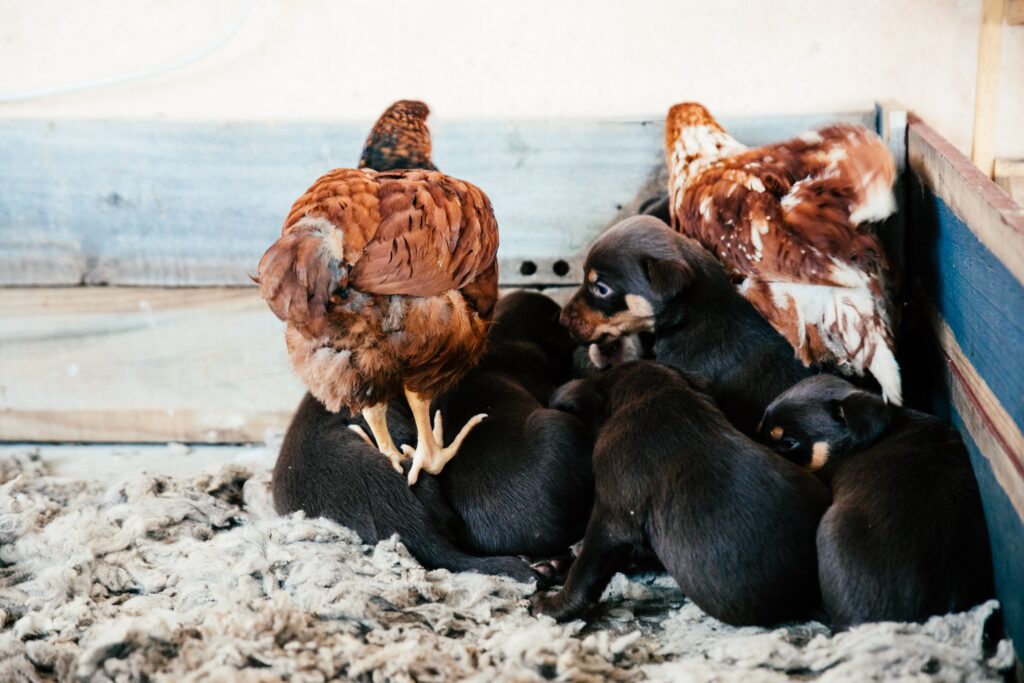
I know. Every week this topic appears on social media. Folks who have no knowledge or experience with either of these breeds continue to recommend these mixes to new farmers. A mixed LGD/Herding breed puppy is continually recommended to farmers looking for a poultry guardian, LGD puppy, or farm protection. Six months later the proud owner wakes up and their beloved new guardian has broken into the stock area and de-feathered, chased, maimed, and killed the stock they were intended to protect.
If you have never observed the devastation of your precious stock killed, disemboweled, and spread about your property perhaps you cannot understand why shepherds are so adamant that the mixes are not suitable as flock protectors. However, those who have witnessed this will continue to educate and help upcoming farmers avoid this bitter lesson.
It’s common sense really. Marathon runners and gymnasts would not be appropriate for a country’s military defense. A country wouldn’t argue- but they’re athletic and we can train anyone to do any job. They would choose from their proven military units to defend the country as safely as possible with minimal risk to civilians or their defense units. This is the equivalent of choosing an LGD breed over a herding breed as a guardian option.
Why is this Mix Destined to Fail as an LGD?
A herding breed dog is not equipped with the instinct, prowess, size, or teeth to safely and effectively combat predators and calm stock. They are high-strung, prone to nipping, pushing, and disrupting stock. They are at best purposefully disruptive of stock, and at worst will chase, bite and eat stock if left unsupervised. They are at risk for serious injury or death if they are faced with normal stock predators like raccoons, coyotes etc.
Working LGDs were selected for over 6000 years to bring security, and peace to their flocks and domains. Their appearance was intended to be both powerful and calming. Their faces and mannerisms are calm, causing stock to relax and thrive in their presence. Their strength and safety make them a deterrent to even the largest apex predators.
Herding Dog Breeds: A Brief Overview
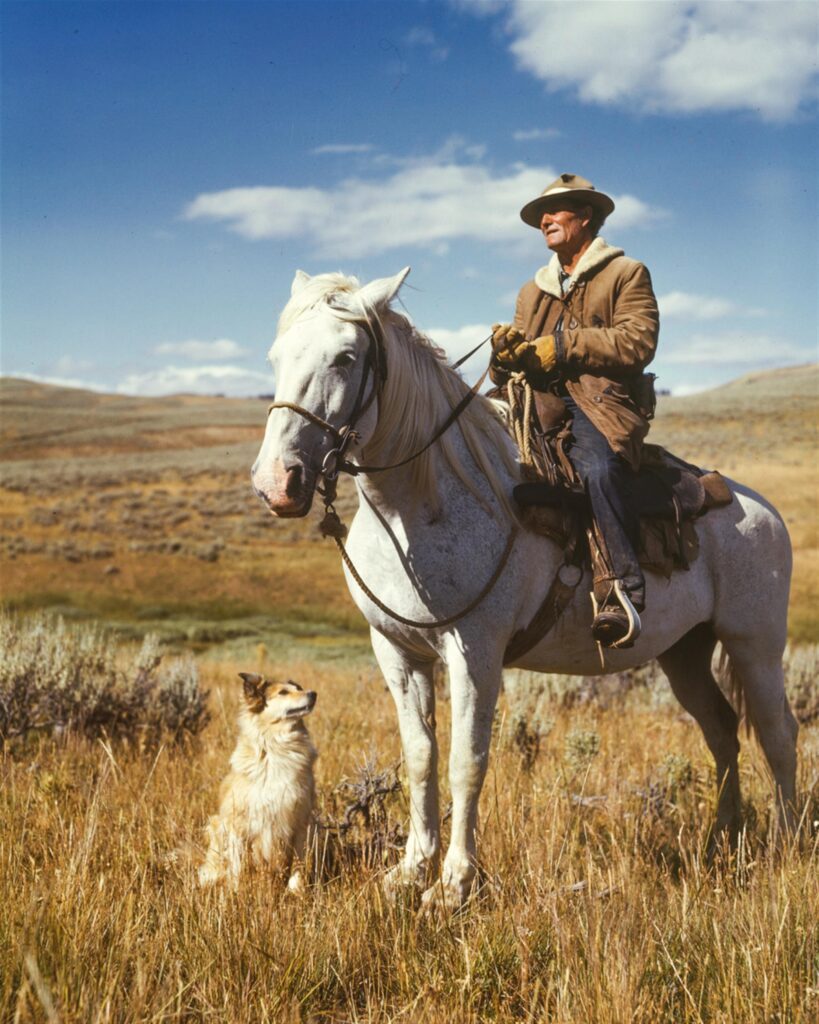
Herding Breed History
In 1570, Dr. Johannes Caius named this herding type of working dog ‘shepherd’s dog’ in his Latin Classification Article.
In England, there are no bloodthirsty wolves, so our Shepherd’s Dog (the second kind) is not huge, vast, or big, but of moderate stature and growth. This dog either at the hearing of his master’s voice, or at the wagging and whistling in his fist, or at his shrill and hoarse hissing, brings the wandering wethers [castrated male ram] and straying sheep into the self-same place where his master’s will and wish is to have them: whereby the shepherd reaps this benefit, namely, that with little labor and no toil or moving of his feet, he may rule and guide his flock, according to his own desire; either to have them go forward, or to stand still, or to draw backward, or to turn this way, or to take that way.
The herding breed dogs were recorded in Iceland as early as the 13th century and were popular in England and Europe by the 17th century. Developed as a working group the herding breed is apporximately 950 years old. They were developed thousands of years after the Livestock Guardian Dog Breeds. The livestock guard dog’s job is best accomplished by not disrupting the flock. This is done by protecting and calming the animals. However, a Herding Dog’s job consists of disrupting the herd and pushing them in the direction the Shepherd has prescribed.
Herding Breeds Today

The working herding breeds never cease to amaze me. I could watch them work under a shepherd all morning guiding and pushing their flock where it needed to move. A few hours later they would have the energy to go again. Always ready to work, with an obsessive desire to get things done.
Health-wise, herding dog breeds rarely suffer from hip dysplasia but are prone to a few other health issues. They are brave and vigilant dogs with incredible loyalty, intelligence, biddability, versatility, and energy. They are innately territorial as well and will bark at intruders.
Herding dog breeds are high-energy dogs with medium to high exercise needs. They also need to put their brains to work and require frequent mental stimulation, which is owed to their intelligence. Since they are highly trainable, you can easily teach them new skills and routines. They are prone to unwanted boredom behaviors if they are not given sufficient physical and mental stimulation.
Characteristics of Herding Breed-Type Dogs

Great as Working Dogs
Herding dogs need a job to do. They are known to be biddable, hard-working, athletic, and willing to please. They exhibit strong prey drive and herding characteristics. Sheep herding is a controlled hunting drive, directed by a human so that dogs and not humans move the flocks. Working line herding dogs are some of the most athletic working dogs in the canine world and are widely known for their working capabilities. Although they were developed for herding, they can do much more. Given their tough, trainable, and adaptable characteristics they excel at agility, herding work, seeing eye dogs, cheering up the sick, and companions for active families.
Highly Intelligent and Biddable Dogs
Known for their biddability and smart skills, herding breeds rank above average in intelligence.
They are loyal, vivacious, cheerful and active dogs. Willing to ride and die with their owners, willing to spin in circles just to make them happy. They live for jobs, love, and the next thing to dog. They make excellent family companions but must receive excessive mental activity and stimulation or they can become nuerotic. They are compassionate, needy, and live to please their owners.
Where Does the Herding Instinct Come From?

The herding instinct is a strong guiding force of today’s herding breeds. It is a common conclusion that the herding instinct is a controlled prey/ chase drive channeled into a working format. Herding/ prey drive derives from hunting. A herding dog sees the livestock as prey, not to eat but to move and push into a correct formation. But does it go deeper then this?
For example, the sheep herding breeds are characterized by genetic variants associated with a neurodevelopmental process known as axon guidance, which helps ensure that neurons are wired together correctly. Some of these variants were specifically associated with genes that have been linked to anxiety and maternal behaviors, including pup retrieval in mice.
Science has proven that the brain pathways of herding breeds are deeply instinctively ingrained to function in the roles they were originally created to do. By respecting this instinct we can give the herding breed dogs jobs where they are both physically and mentally stimulated.
LGD Breeds- An Overview
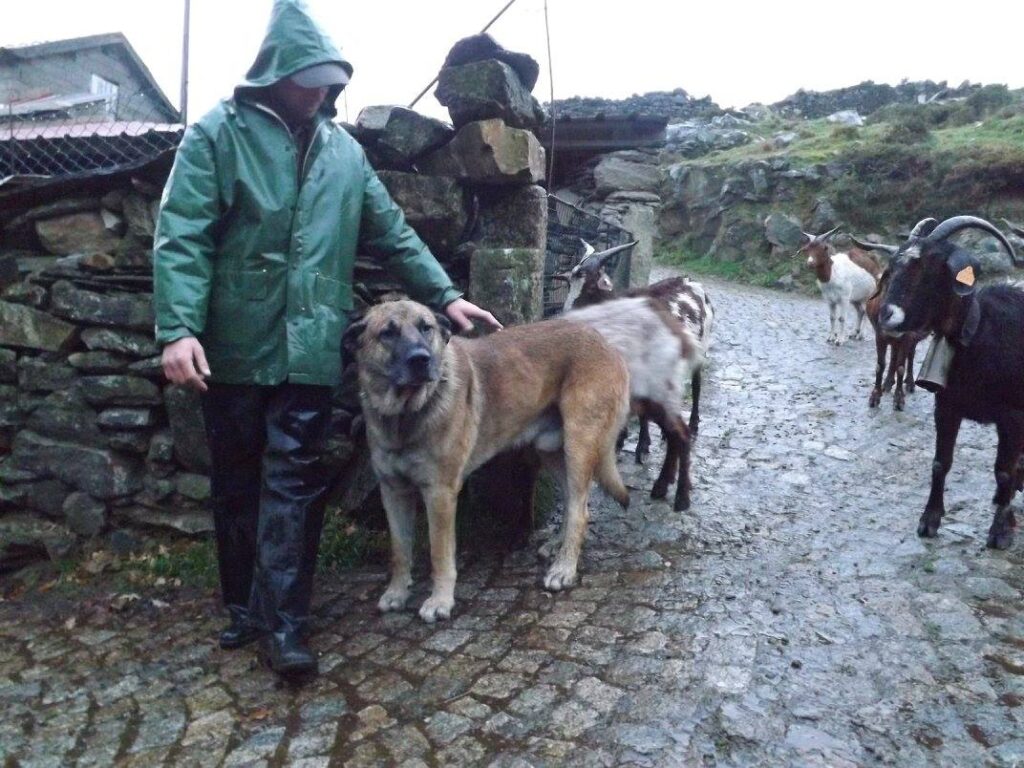
LGD Origin History
Throughout Europe, Asia, and North Africa, where livestock and predators clashed, local populations developed their own breeds of dogs to protect them. It is believed that sheep were domesticated in 9,000 B.C. “The spreading of Livestock Guardian Dogs of Eurasia is identical to the spreading of sheep both geographically and in time” – Dr. Kovacs
The evolution of the Livestock Guardian Dog breeds we know today followed the gradual migration of nomadic people with their flocks of domestic sheep and goats originating in East Asia and spreading throughout Europe. The LGD role is estimated to be approximately 4,000 years old. It is believed that it took this long for dogs to become selected for their specialized role to protect their herds of sheep and goats. The dogs integrated into their herds while living among them with the shepherds. Evidence from modern DNA shows that the greatest amount of genetic diversity of domesticated wolves was available in East Asia to serve as the basis for selection.
The Roman scholar Marcus Terentius Varro (116-27BC)[5], recorded the use of livestock guardian dogs at that time. He classified that they were most likely descended from a Molossoid Mastin type of dog. Some of the most authentic LGD breeds still carry these Mollosoid Mastin roots, such as the original working Spanish mastin, the short haired Cao da Serra da Estrela and the Kangal.
LGD Breeds Today
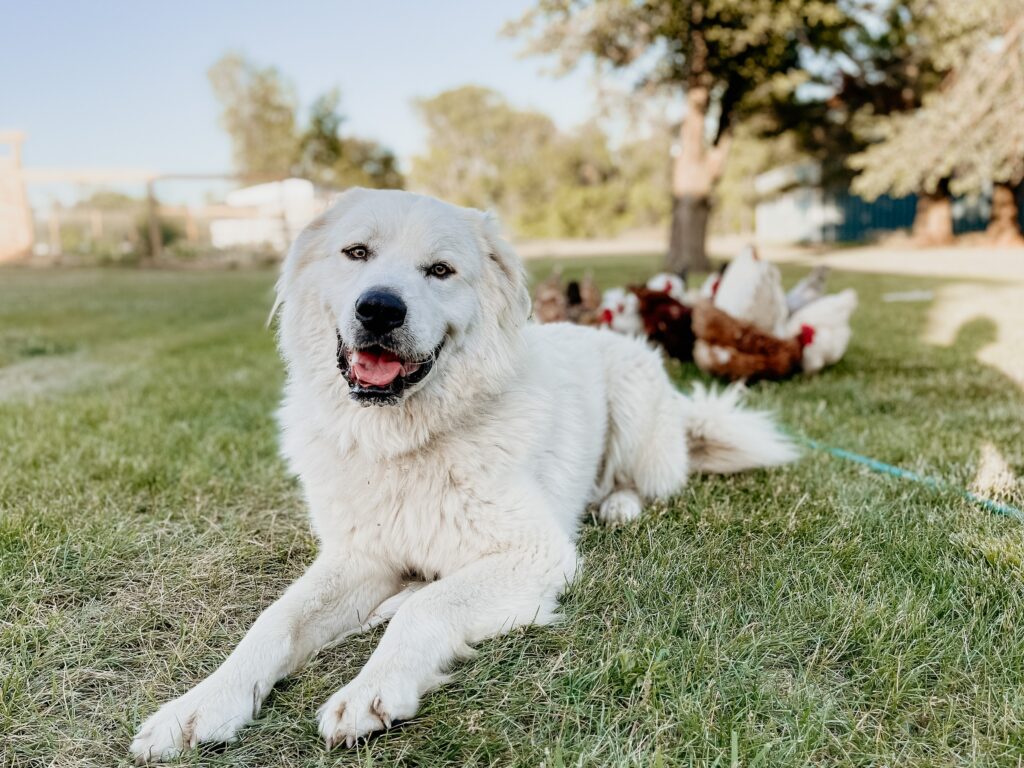
The popularity of LGD breeds has seen an upswing in the last decades. From large commercial ag operations to small homesteads with flocks of chickens, LGD breeds are sought out to provide the millennium-old barrier between domesticated stock and native predators. The breeds have been defended, shepherded, misunderstood, ostracized, and exploited but there are few things as valuable in life as a solid LGD. Throughout the world, they serve as alarm systems, flock protectors, canine mothers, stubborn defenders, OCD supervisors, and companions to their shepherds.
LGD dog breeds are low-energy dogs with low to medium exercise needs. They are intelligent, independent thinkers, they thrive when they are given a job. They are not a highly biddable ride and die type working group. It is important for them to know why they are riding, who else is coming, and what threat is threatening the mission in order to prevent anyone from dying at all. They are prone to boredom behaviors like excess barking, destructive chewing, and roaming if they are not given guidance, mental stimulation and boundaries.
LGD Working Breed Characteristics
Independent and Intuitively Suspicious
The independent and intuitively suspicious Guardian character is an appreciable virtue and should never be neglected. It is a key component in the dog’s ability to effectively protect stock and understand its function. A well-balanced LGD is a defense breed, never an unprovoked aggression breed. Its suspicion is key to its ability to evaluate its environment and to make judgments following its owner’s guidance. An LGD breed that loses this will be unstable and unfit to carry the name. Many of these dogs are too soft, leaving their stock to be exploited by 4-legged predators as well as humans. The other 50% of such a breed will be too quick to attack humans, they will lack intuition to aptly detect legit threats.
The renowned European dog behaviorist German Miranda stated about the suspicious independent LGD nature after meeting an autochthonous mastin breed –
Its independence is limited only to strangers, devoting himself to the ones who belong to his domain. He forms a very special bond with his owner, to whom he devotes an unbreakable friendship. For this owner, it is capable of laying down its own life. I have concluded that the Serra da Estrela is an intelligent, honorable animal”.
Low Prey Drive – Resolute Defense Skills
Known for their independence, problem solving skills and resolute defense the LGD breeds are often misunderstood and undervalued. They may never be the biddable vivacious that their herding dog breed cousins are, but they are equally deserving of appreciation and human companionship.
Well balanced LGD breeds are equally bonded to their owner and his livestock. They guard the stock because it is the owners, whatever belongs to the owner they also assume belongs to them. They are a dedicated, compassionate and intuitive working group of dogs.
The physical appearance and size of an LGD should be large enough to dominate in a fight with large predators but not so large as to be clumsy and inept. Too much size is a very real threat to LGDs in health, athleticism, and function. Dew claws are natural and desirable in ALL guardian dog breeds. All cattle and mountain dogs alike feature them, and it is the physical feature that shepherds across Europe value most.
Although a dog’s behavior and temperament usually depend on genetics, they tend to be bonded to their owners, suspicious of strangers and devoted to their stock. LGDs are very loyal to their owners, a hardworking, intelligent and faithful friend for the long days spent in the fields.
Is The Guardian Nature Instinctive? Can Instincts be Taught?
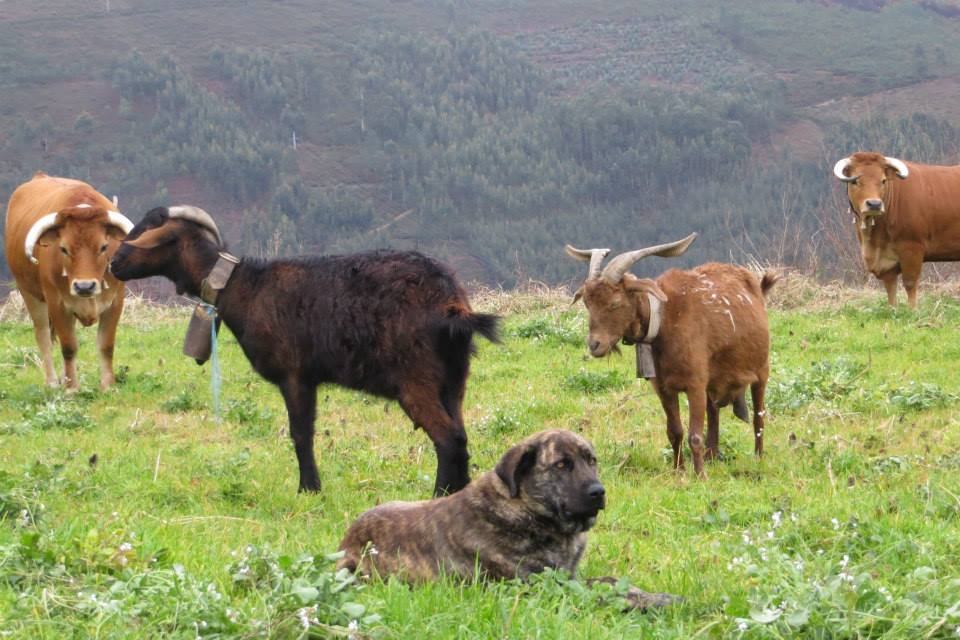
Instincts, by definition, are inherited behaviors, not learned. It’s not recommended to say “genetically determined,” but hereditary genes are the primary factor in instinct. Instinctive behaviors can be modified by learning and can be encouraged with guidance. (With dogs, for example, when we teach them to bark at aerial hawks but to ignore & protect the chickens scratching in the yard).
There are many dog behaviors that are instinctive, but which for the good of the flock, have been suppressed in LGD breeds. LGD breeds have been selected for 6000 years to instinctively guard whatever their owner owns, to bond with their flocks and maintain a trustworthy and loyal character.
Can We Teach Guardian Instincts?
By definition an instinct is NOT a learned behavior. All instincts are by their very nature complex neurocognitive mapping. Instincts are biologically based. So instinctive behaviors are passed on from one generation to the next but they are heavily influenced through interactions with the environment.
Environmental factors are responsible for the appearance of instincts in all species.
There is a very complex interaction between what is carried by genes and what is promoted by the environment. They are really inseparable. But it is acceptable to say that whatever neural paths are created by genetic inheritance, they are not ‘activated” unless the proper environment is present.
Activating and Guiding the Guardian instinct is a whole subject on its own. But the short answer is No, we cannot teach a species to instinctively perform a function. We can only activate and encourage the instincts that the species genetically inherited.
If a herding breed carries the instinct to chase and disrupt flocks, we must utilize and guide this instinct in the channels it was meant to fill. If an LGD carries the instinct to defend and bond to livestock, this instinct must be nourished and given the space to develop appropriately with guidance.
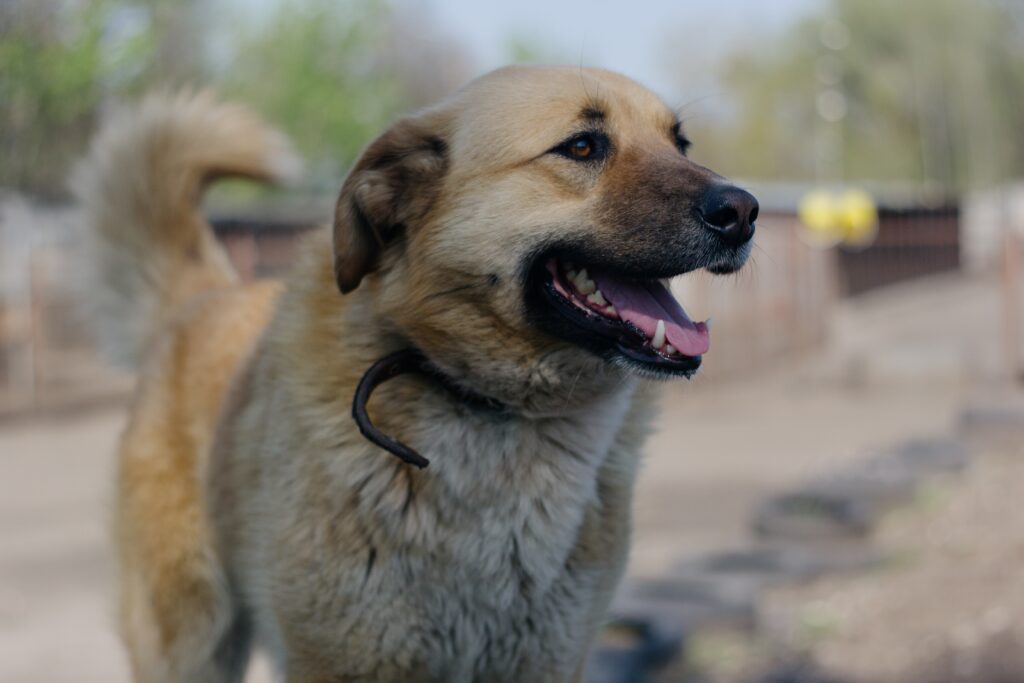
Final Thoughts- Livestock Guardian Dogs vs Herding Dog Breeds
You can choose which shepherd dog breed is the right fit for you by matching your expectations with the jobs they are created to do. Working line LGDs are bred to have flock protection abilities, whereas herding dogs breeds are bred to have chasing and herding flock instincts.
LGDs that develop chasing instincts are predators, and herding breeds that are low energy and defensive have lost the working drive and biddability that made them famous.
- Both types have specific differences in personality, purpose, and physical attributes but are equally excellent working and companion dogs.
- Both are very loving and devoted, essential to shepherds and flocks.
- Both of them come with their fair share of responsibilities, and thus you should only own one if you can ensure their safety and give them the life deserve.
Related Posts You May Like:
Comments +